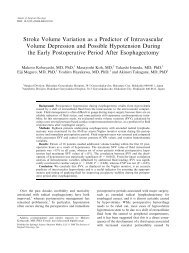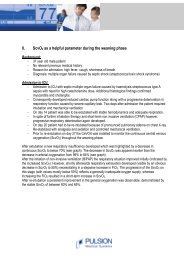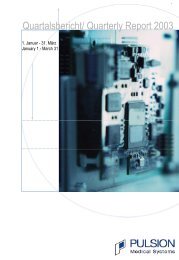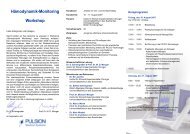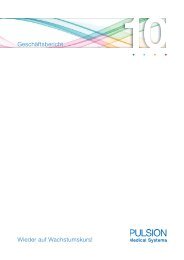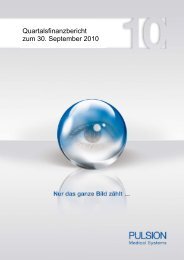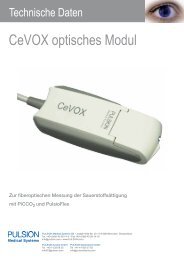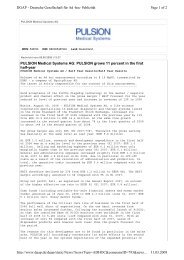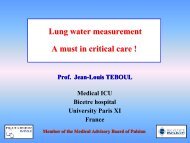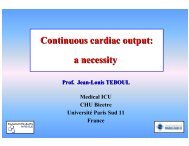The new england journal of medicine - PULSION Medical Systems SE
The new england journal of medicine - PULSION Medical Systems SE
The new england journal of medicine - PULSION Medical Systems SE
Create successful ePaper yourself
Turn your PDF publications into a flip-book with our unique Google optimized e-Paper software.
pulmonary-artery or central venous catheter therapy for lung injury<br />
Table 2. Catheter-Related Complications.<br />
Complication PAC Group CVC Group<br />
Sheath PAC CVC Total Sheath CVC Total<br />
number <strong>of</strong> patients<br />
Technical and mechanical<br />
complications<br />
Difficult placement 1 8 1 10 0 2 2<br />
Catheter malfunction 0 4 0 4 0 0 0<br />
Pneumothorax 3 2 1 6 0 6 6<br />
Air embolism 1 1 1 3 0 0 0<br />
Arterial puncture<br />
Arrhythmia<br />
1 0 2 3 0 0 0<br />
Atrial 3 15 0 18 0 0 0<br />
Ventricular 4 15 0 19 1 5 6<br />
Conduction defect<br />
Bleeding and clotting<br />
1 4 0 5 1 0 1<br />
Hemothorax 2 1 0 3 1 0 1<br />
Insertion-site bleeding 2 1 3 6 1 2 3<br />
Thromboembolism 0 0 0 0 1 0 1<br />
Local thrombosis<br />
Infection<br />
1 1 1 3 0 6 6<br />
Local 3 2 7 12 1 8 9<br />
Bloodstream* 1 3 1 5 0 3 3<br />
Other 0 2 1 3 0 3 3<br />
Total 23 59 18 100 6 35 41<br />
* Positive blood cultures were believed to be related to the presence <strong>of</strong> the catheter. Overall, 19 percent <strong>of</strong> patients in the<br />
PAC group and 18 percent <strong>of</strong> patients in the CVC group had one or more positive blood cultures (P = 0.43).<br />
Lung Function<br />
Ventilator settings and lung-function measures<br />
were similar in the two groups over time, with<br />
no significant differences in the respiratory rate,<br />
tidal volume, positive end-expiratory pressure,<br />
plateau pressure, PaO 2 :FIO 2 , pH, partial pressure<br />
<strong>of</strong> arterial carbon dioxide, oxygenation index, or<br />
lung injury score (Table 4 <strong>of</strong> the Supplementary<br />
Appendix).<br />
Metabolic and Renal Function<br />
While the hemodynamic management protocol<br />
was in use, there were no significant differences<br />
between groups in electrolyte, albumin, or hemoglobin<br />
levels (data not shown), although a higher<br />
percentage <strong>of</strong> patients in the PAC group than in<br />
the CVC group received erythrocyte transfusions<br />
(38 percent vs. 30 percent, P = 0.008). <strong>The</strong>re were<br />
no significant differences between groups in<br />
the percentage <strong>of</strong> patients treated with kidneyreplacement<br />
therapy (14 percent in the PAC group<br />
vs. 11 percent in the CVC group, P = 0.15).<br />
Discussion<br />
Because the PAC provides unique physiological<br />
information, it has been assumed that the use <strong>of</strong><br />
this catheter would improve survival and decrease<br />
the duration <strong>of</strong> assisted ventilation and the rate <strong>of</strong><br />
organ failure among patients with acute lung injury.<br />
Eroding this belief are observational and prospective<br />
trials indicating that such outcomes are<br />
not improved and may even be worsened by PAC<br />
use. 19-25 Since the initiation <strong>of</strong> this study, random-<br />
n engl j med 354;21 www.nejm.org may 25, 2006 2219<br />
Downloaded from www.nejm.org at COLUMBIA UNIV HEALTH SCIENCES LIB on May 22, 2006 .<br />
Copyright © 2006 Massachusetts <strong>Medical</strong> Society. All rights reserved.





